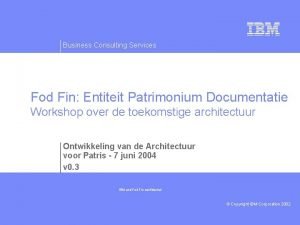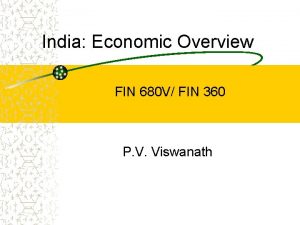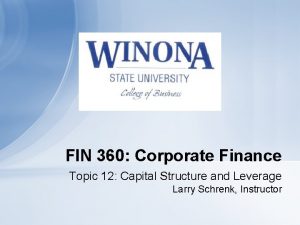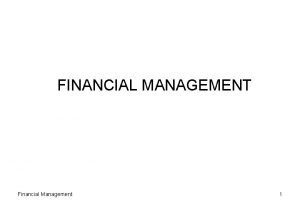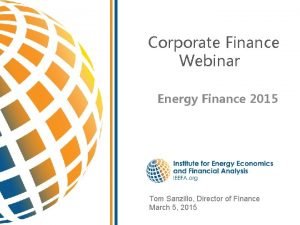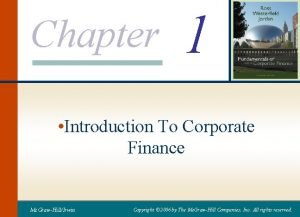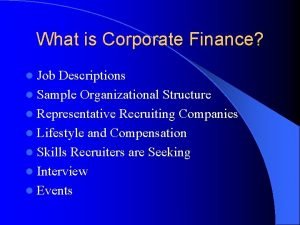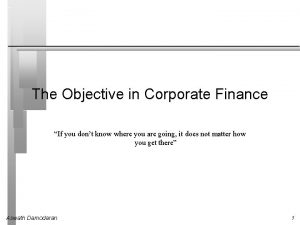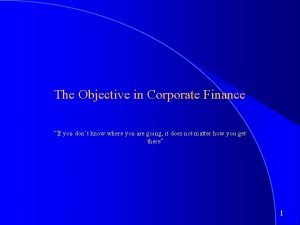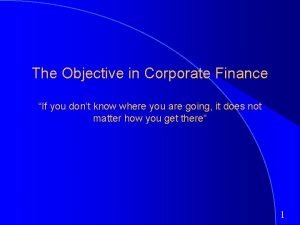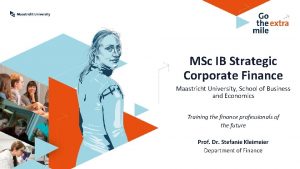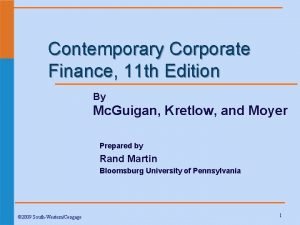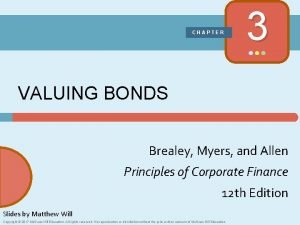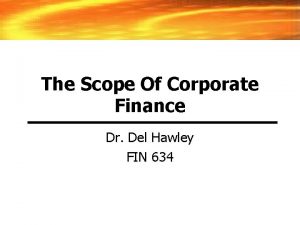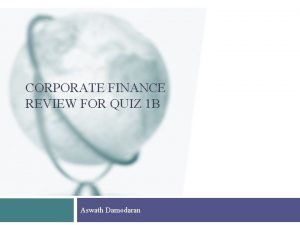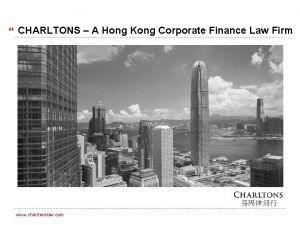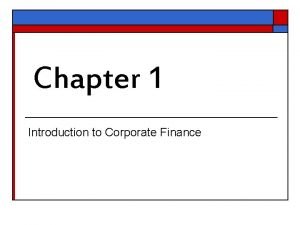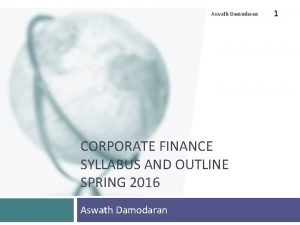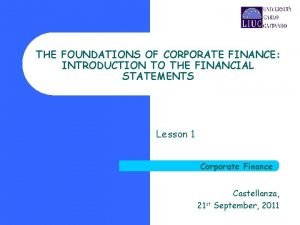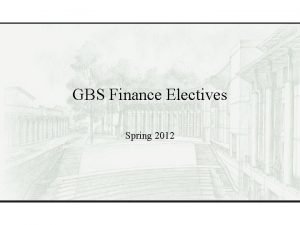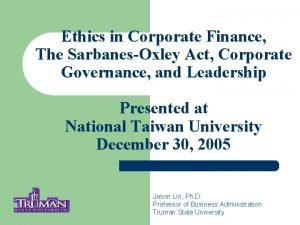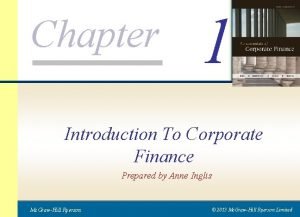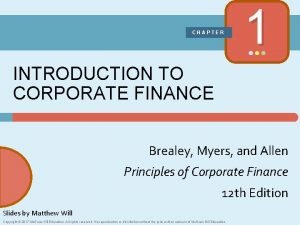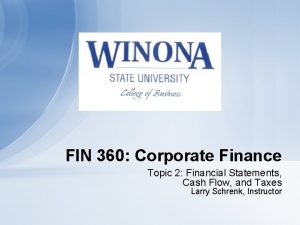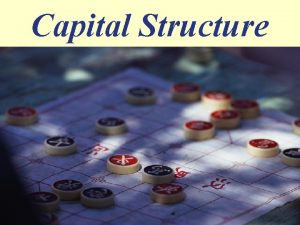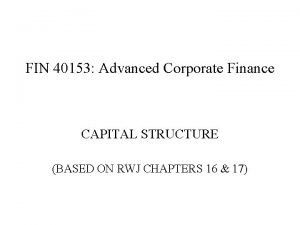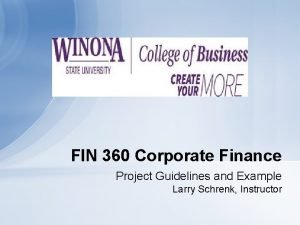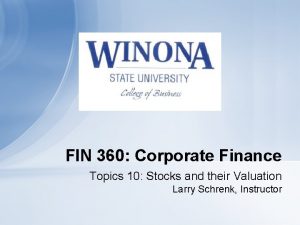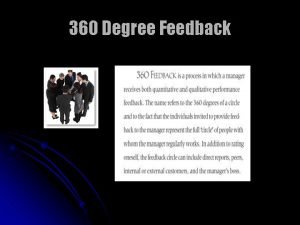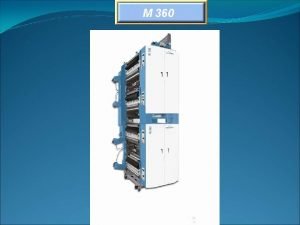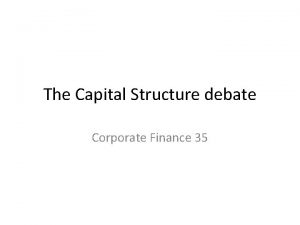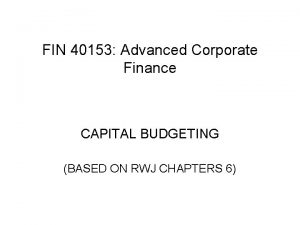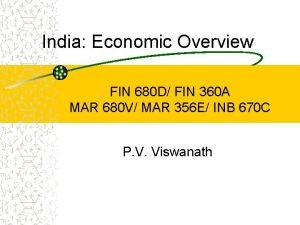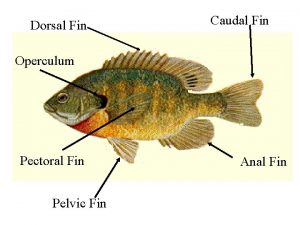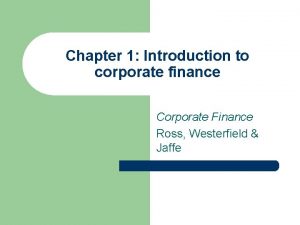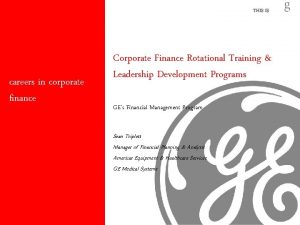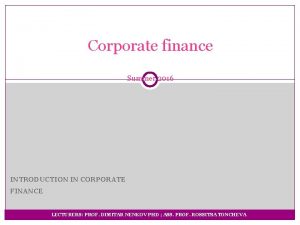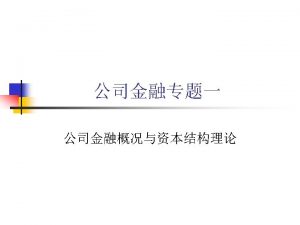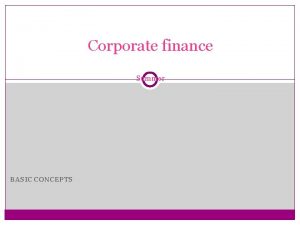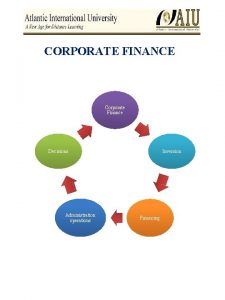FIN 360 Corporate Finance Topic 12 Capital Structure



































- Slides: 35

FIN 360: Corporate Finance Topic 12: Capital Structure and Leverage Larry Schrenk, Instructor 10: 17 PM 1 of 35

Topics • Leverage • Miller-Modigliani Propositions • Financial Distress, etc. • Bankruptcy 10: 17 PM 2 of 35

Capital Structure and the Pie • The value of a firm is defined to be the sum of the value of the firm’s debt and the firm’s equity. V=B+S • If the goal of the firm’s management is to make the firm as valuable as possible, then the firm should pick the debt-equity ratio that makes the pie as big as possible. S B Value of the Firm 10: 17 PM 3 of 35

Stockholder Interests There are two important questions: 1. Why should the stockholders care about maximizing firm value? Perhaps they should be interested in strategies that maximize shareholder value. 2. What is the ratio of debt-to-equity that maximizes the shareholder’s value? As it turns out, changes in capital structure benefit the stockholders if and only if the value of the firm increases. 10: 17 PM 4 of 35

Financial Leverage, EPS, and ROE Consider an all-equity firm that is considering going into debt. (Maybe some of the original shareholders want to cash out. ) Current Assets $20, 000 Debt $0 Equity $20, 000 Debt/Equity ratio 0. 00 Interest rate n/a Shares outstanding 400 Share price $50 10: 17 PM Proposed $20, 000 $8, 000 $12, 000 2/3 8% 240 $50 5 of 35

EPS and ROE under Current Structure Recession Expected Expansion EBIT $1, 000 $2, 000 $3, 000 Interest 0 0 0 Net income $1, 000 $2, 000 $3, 000 EPS $2. 50 $5. 00 $7. 50 ROA 5% 10% 15% ROE 5% 10% 15% Current Shares Outstanding = 400 shares 10: 17 PM 6 of 35

EPS and ROE under Proposed Structure Recession Expected Expansion EBIT $1, 000 $2, 000 $3, 000 Interest 640 640 Net income $360 $1, 360 $2, 360 EPS $1. 50 $5. 67 $9. 83 ROA 1. 8% 6. 8% 11. 8% ROE 3. 0% 11. 3% 19. 7% Proposed Shares Outstanding = 240 shares 10: 17 PM 7 of 35

Assumptions of the Miller-Modigliani (MM) Model • Homogeneous Expectations • Homogeneous Business Risk Classes • Perpetual Cash Flows • Perfect Capital Markets: – – – Perfect competition Firms and investors can borrow/lend at the same rate Equal access to all relevant information No transaction costs No taxes 10: 17 PM 8 of 35

Homemade Leverage: An Example Recession Expected Expansion EPS of Unlevered Firm $2. 50 $5. 00 $7. 50 Earnings for 40 shares $100 $200 $300 Less interest on $800 (8%) $64 $64 Net Profits $36 $136 $236 ROE (Net Profits / $1, 200) 3. 0% 11. 3% 19. 7% We are buying 40 shares of a $50 stock, using $800 in margin. We get the same ROE as if we bought into a levered firm. Our personal debt-equity ratio is: 10: 17 PM 9 of 35

Homemade (Un)Leverage: An Example Recession Expected Expansion EPS of Levered Firm $1. 50 $5. 67 $9. 83 Earnings for 24 shares $36 $136 $236 Plus interest on $800 (8%) $64 $64 Net Profits $100 $200 $300 ROE (Net Profits / $2, 000) 5% 10% 15% Buying 24 shares of an otherwise identical levered firm along with some of the firm’s debt gets us to the ROE of the unlevered firm. This is the fundamental insight of M&M 10: 17 PM 10 of 35

MM Proposition I (No Taxes) • We can create a levered or unlevered position by adjusting the trading in our own account. • This homemade leverage suggests that capital structure is irrelevant in determining the value of the firm: VL = VU VL is the value of the levered firm VU is the value of the unlevered firm 10: 17 PM 11 of 35

3 MM Proposition II (No Taxes) • Proposition II – Leverage increases the risk and return to stockholders Rs = R 0 + (B/SL) (R 0 - RB) RB is the interest rate (cost of debt) Rs is the return on (levered) equity (cost of equity) R 0 is the return on unlevered equity (cost of capital) B is the value of debt SL is the value of levered equity 10: 17 PM 12 of 35

Cost of Capital: R (%) MM Proposition II (No Taxes) R 0 RB RB Debt-to-Equity Ratio 10: 17 PM 13 of 35

4 MM Propositions I & II (With Taxes) • Proposition I (with Corporate Taxes) – Firm value increases with leverage VL = V U + T C B VL is the value of the levered firm VU is the value of the unlevered firm Tc is the corporate tax rate B is the value of the debt • Proposition II (with Corporate Taxes) – Some of the increase in equity risk and return is offset by the interest tax shield RS = R 0 + (B/S)×(1 -TC)×(R 0 - RB) RB is the interest rate (cost of debt) RS is the return on equity (cost of equity) R 0 is the return on unlevered equity (cost of capital) B is the value of debt S is the value of levered equity 10: 17 PM 14 of 35

Cost of Capital: R (%) The Effect of Financial Leverage R 0 RB Debt-to-Equity Ratio 10: 17 PM 15 of 35

Levered All Equity Total Cash Flow to Investors EBIT Interest EBT Taxes (Tc = 35%) Total Cash Flow to S/H EBIT Interest ($800 @ 8% ) EBT Taxes (Tc = 35%) Total Cash Flow (to both S/H & B/H): EBIT(1 -Tc)+TCRBB 10: 17 PM Recession $1, 000 0 $1, 000 $350 Expected $2, 000 0 $2, 000 $700 Expansion $3, 000 0 $3, 000 $1, 050 $650 Recession $1, 000 640 $360 $126 $234+640 $874 $650+$224 $874 $1, 300 Expected $2, 000 640 $1, 360 $476 $884+$640 $1, 524 $1, 300+$224 $1, 524 $1, 950 Expansion $3, 000 640 $2, 360 $826 $1, 534+$640 $2, 174 $1, 950+$224 $2, 174 16 of 35

Total Cash Flow to Investors All-equity firm S Levered firm G S G B The levered firm pays less in taxes than does the all-equity firm. Thus, the sum of the debt plus the equity of the levered firm is greater than the equity of the unlevered firm. This is how cutting the pie differently can make the pie “larger. ”–the government takes a smaller slice of the pie! 10: 17 PM 17 of 35

Summary: No Taxes • In a world of no taxes, the value of the firm is unaffected by capital structure. • This is M&M Proposition I: VL = VU • Proposition I holds because shareholders can achieve any pattern of payouts they desire with homemade leverage. • In a world of no taxes, M&M Proposition II states that leverage increases the risk and return to stockholders. 10: 17 PM 18 of 35

Summary: Taxes • In a world of taxes, but no bankruptcy costs, the value of the firm increases with leverage. • This is M&M Proposition I: VL = V U + T C B • Proposition I holds because shareholders can achieve any pattern of payouts they desire with homemade leverage. • In a world of taxes, M&M Proposition II states that leverage increases the risk and return to stockholders. 10: 17 PM 19 of 35

Costs of Financial Distress • Direct Costs – Legal and administrative costs • Indirect Costs – Impaired ability to conduct business (e. g. , lost sales) – Agency Costs • Selfish Strategy 1: Incentive to take large risks • Selfish Strategy 2: Incentive toward underinvestment • Selfish Strategy 3: Milking the property 10: 17 PM 20 of 35

Example: Company in Distress Assets BV MV Cash $200 Fixed Asset $400 $0 Total $600 $200 Liabilities LT bonds Equity Total BV MV $300 $200 $0 $300 $600 $200 What happens if the firm is liquidated today? The bondholders get $200; the shareholders get nothing. 10: 17 PM 21 of 35

Selfish Strategy 1: Take Risks The Gamble Win Big Lose Big Probability 10% 90% Payoff $1, 000 $0 Cost of investment is $200 (all the firm’s cash) Required return is 50% Expected CF from the Gamble = $1000 × 0. 10 + $0 = $100 NPV = –$200 + (1. 50) NPV = –$133 10: 17 PM 22 of 35

Selfish Strategy 1: Take Risks • Expected CF from the Gamble – To Bondholders = $300 × 0. 10 + $0 = $30 – To Stockholders = ($1000 – $300) × 0. 10 + $0 = $70 • PV of Bonds Without the Gamble = $200 • PV of Stocks Without the Gamble = $0 • PV of Bonds With the Gamble: • PV of Stocks With the Gamble: 10: 17 PM $20 = $47 = $30 (1. 50) $70 (1. 50) 23 of 35

Selfish Strategy 2: Underinvestment • Consider a government-sponsored project that guarantees $350 in one period. • Cost of investment is $300 (the firm only has $200 now), so the stockholders will have to supply an additional $100 to finance the project. • Required return is 10%. $350 NPV = –$300 + (1. 10) NPV = $18. 18 · Should we accept or reject? 10: 17 PM 24 of 35

Selfish Strategy 2: Underinvestment Expected CF from the government sponsored project: To Bondholder = $300 To Stockholder = ($350 – $300) = $50 PV of Bonds Without the Project = $200 PV of Stocks Without the Project = $0 PV of Bonds With the Project: $272. 73 = PV of Stocks With the Project: – $54. 55 = 10: 17 PM $300 (1. 10) $50 (1. 10) – $100 25 of 35

Selfish Strategy 3: Milking the Property • Liquidating dividends – Suppose our firm paid out a $200 dividend to the shareholders. This leaves the firm insolvent, with nothing for the bondholders, but plenty for the former shareholders. – Such tactics often violate bond indentures. • Increase perquisites to shareholders and/or management 10: 17 PM 26 of 35

Can Costs of Debt Be Reduced? • Protective Covenants • Debt Consolidation: – If we minimize the number of parties, contracting costs fall. 10: 17 PM 27 of 35

Tax Effects and Financial Distress • There is a trade-off between the tax advantage of debt and the costs of financial distress. • It is difficult to express this with a precise and rigorous formula. 10: 17 PM 28 of 35

Tax Effects and Financial Distress Value of firm (V) Value of firm under MM with corporate taxes and debt Present value of tax shield on debt V L = V U + T CB Maximum Firm Value Present value of financial distress costs V = Actual value of firm VU = Value of firm with no debt 0 10: 17 PM B* Optimal Amount of Debt (B) 29 of 35

The Pie Model Revisited • Taxes and bankruptcy costs can be viewed as just another claim on the cash flows of the firm. • Let G and L stand for payments to the government and bankruptcy lawyers, respectively. S • VT = S + B + G + L B • Key Ideas: – VT depends on the cash flow of the firm. – Capital structure just slices the pie. 10: 17 PM L G 30 of 35

Signaling • The firm’s capital structure is optimized where the marginal subsidy to debt equals the marginal cost. • Investors view debt as a signal of firm value. – Firms with low anticipated profits will take on a low level of debt. – Firms with high anticipated profits will take on a high level of debt. • A manager that takes on more debt than is optimal in order to fool investors will pay the cost in the long run. 10: 17 PM 31 of 35

The Agency Cost of Equity • An individual will work harder for a firm if he is one of the owners than if he is one of the ‘hired help. ’ • While managers may have motive to partake in perquisites, they also need opportunity. Free cash flow provides this opportunity. • The free cash flow hypothesis says that an increase in dividends should benefit the stockholders by reducing the ability of managers to pursue wasteful activities. • The free cash flow hypothesis also argues that an increase in debt will reduce the ability of managers to pursue wasteful activities more effectively than dividend increases. 10: 17 PM 32 of 35

The Pecking-Order Theory • Theory stating that firms prefer to issue debt rather than equity if internal financing is insufficient. – Rule 1 • Use internal financing first. – Rule 2 • Issue debt next, new equity last. • The pecking-order theory is at odds with the tradeoff theory: – There is no target D/E ratio. – Profitable firms use less debt. – Companies like financial slack. 10: 17 PM 33 of 35

The Bankruptcy Process • Business Failure–Business has terminated with a loss to creditors • Legal Bankruptcy–Petition federal court for bankruptcy • Technical Insolvency–Firm is unable to meet debt obligations • Accounting Insolvency–Book value of equity is negative 10: 17 PM 34 of 35

The Bankruptcy Process • Liquidation – Chapter 7 of the Federal Bankruptcy Reform Act of 1978 – Trustee takes over assets, sells them, and distributes the proceeds (Absolute Priority Rule) • Reorganization – Chapter 11 of the Federal Bankruptcy Reform Act of 1978 – Restructure the corporation with a provision to repay creditors 10: 17 PM 35 of 35
 Objective of corporate governance
Objective of corporate governance Spf fin fod fin
Spf fin fod fin Faces superposables
Faces superposables Fin 360
Fin 360 Mm proposition i with taxes
Mm proposition i with taxes Multinational cost of capital and capital structure
Multinational cost of capital and capital structure Multinational cost of capital and capital structure
Multinational cost of capital and capital structure Fundamentals of corporate finance chapter 6 solutions
Fundamentals of corporate finance chapter 6 solutions Financial management theory
Financial management theory Tom sanzillo
Tom sanzillo Investment banking activities
Investment banking activities Introduction to corporate finance what companies do
Introduction to corporate finance what companies do Corporate finance job scope
Corporate finance job scope Objective of corporate finance
Objective of corporate finance Objective of corporate finance
Objective of corporate finance Objective of corporate finance
Objective of corporate finance Maastricht university ib
Maastricht university ib Fundamentals of corporate finance, chapter 1
Fundamentals of corporate finance, chapter 1 Contemporary corporate finance
Contemporary corporate finance Principles of corporate finance chapter 3 solutions
Principles of corporate finance chapter 3 solutions Scope of corporate finance
Scope of corporate finance Objective of corporate governance
Objective of corporate governance Fundamentals of corporate finance 3rd canadian edition
Fundamentals of corporate finance 3rd canadian edition Introduction to corporate finance quiz
Introduction to corporate finance quiz Charlton law firm
Charlton law firm Corporate finance tenth edition
Corporate finance tenth edition Corporate finance chapter 1
Corporate finance chapter 1 Corporate finance syllabus
Corporate finance syllabus Foundations of corporate finance
Foundations of corporate finance Gbs finance
Gbs finance Fundamentals of corporate finance canadian edition
Fundamentals of corporate finance canadian edition Fundamentals of corporate finance fifth edition
Fundamentals of corporate finance fifth edition Ethics in corporate finance
Ethics in corporate finance Corporate finance overview
Corporate finance overview Chapter 1 introduction to corporate finance
Chapter 1 introduction to corporate finance Chapter 1 introduction to corporate finance
Chapter 1 introduction to corporate finance

